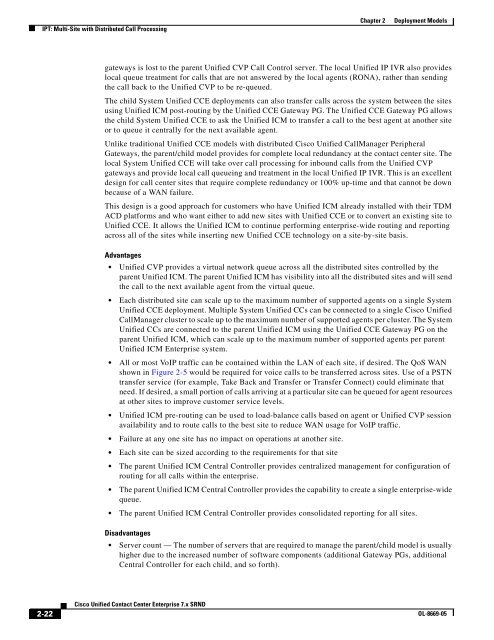Cisco Unified Contact Center Enterprise Solution Reference ...
Cisco Unified Contact Center Enterprise Solution Reference ...
Cisco Unified Contact Center Enterprise Solution Reference ...
Create successful ePaper yourself
Turn your PDF publications into a flip-book with our unique Google optimized e-Paper software.
IPT: Multi-Site with Distributed Call Processing<br />
2-22<br />
<strong>Cisco</strong> <strong>Unified</strong> <strong>Contact</strong> <strong>Center</strong> <strong>Enterprise</strong> 7.x SRND<br />
Chapter 2 Deployment Models<br />
gateways is lost to the parent <strong>Unified</strong> CVP Call Control server. The local <strong>Unified</strong> IP IVR also provides<br />
local queue treatment for calls that are not answered by the local agents (RONA), rather than sending<br />
the call back to the <strong>Unified</strong> CVP to be re-queued.<br />
The child System <strong>Unified</strong> CCE deployments can also transfer calls across the system between the sites<br />
using <strong>Unified</strong> ICM post-routing by the <strong>Unified</strong> CCE Gateway PG. The <strong>Unified</strong> CCE Gateway PG allows<br />
the child System <strong>Unified</strong> CCE to ask the <strong>Unified</strong> ICM to transfer a call to the best agent at another site<br />
or to queue it centrally for the next available agent.<br />
Unlike traditional <strong>Unified</strong> CCE models with distributed <strong>Cisco</strong> <strong>Unified</strong> CallManager Peripheral<br />
Gateways, the parent/child model provides for complete local redundancy at the contact center site. The<br />
local System <strong>Unified</strong> CCE will take over call processing for inbound calls from the <strong>Unified</strong> CVP<br />
gateways and provide local call queueing and treatment in the local <strong>Unified</strong> IP IVR. This is an excellent<br />
design for call center sites that require complete redundancy or 100% up-time and that cannot be down<br />
because of a WAN failure.<br />
This design is a good approach for customers who have <strong>Unified</strong> ICM already installed with their TDM<br />
ACD platforms and who want either to add new sites with <strong>Unified</strong> CCE or to convert an existing site to<br />
<strong>Unified</strong> CCE. It allows the <strong>Unified</strong> ICM to continue performing enterprise-wide routing and reporting<br />
across all of the sites while inserting new <strong>Unified</strong> CCE technology on a site-by-site basis.<br />
Advantages<br />
<strong>Unified</strong> CVP provides a virtual network queue across all the distributed sites controlled by the<br />
parent <strong>Unified</strong> ICM. The parent <strong>Unified</strong> ICM has visibility into all the distributed sites and will send<br />
the call to the next available agent from the virtual queue.<br />
Each distributed site can scale up to the maximum number of supported agents on a single System<br />
<strong>Unified</strong> CCE deployment. Multiple System <strong>Unified</strong> CCs can be connected to a single <strong>Cisco</strong> <strong>Unified</strong><br />
CallManager cluster to scale up to the maximum number of supported agents per cluster. The System<br />
<strong>Unified</strong> CCs are connected to the parent <strong>Unified</strong> ICM using the <strong>Unified</strong> CCE Gateway PG on the<br />
parent <strong>Unified</strong> ICM, which can scale up to the maximum number of supported agents per parent<br />
<strong>Unified</strong> ICM <strong>Enterprise</strong> system.<br />
All or most VoIP traffic can be contained within the LAN of each site, if desired. The QoS WAN<br />
shown in Figure 2-5 would be required for voice calls to be transferred across sites. Use of a PSTN<br />
transfer service (for example, Take Back and Transfer or Transfer Connect) could eliminate that<br />
need. If desired, a small portion of calls arriving at a particular site can be queued for agent resources<br />
at other sites to improve customer service levels.<br />
<strong>Unified</strong> ICM pre-routing can be used to load-balance calls based on agent or <strong>Unified</strong> CVP session<br />
availability and to route calls to the best site to reduce WAN usage for VoIP traffic.<br />
Failure at any one site has no impact on operations at another site.<br />
Each site can be sized according to the requirements for that site<br />
The parent <strong>Unified</strong> ICM Central Controller provides centralized management for configuration of<br />
routing for all calls within the enterprise.<br />
The parent <strong>Unified</strong> ICM Central Controller provides the capability to create a single enterprise-wide<br />
queue.<br />
The parent <strong>Unified</strong> ICM Central Controller provides consolidated reporting for all sites.<br />
Disadvantages<br />
Server count — The number of servers that are required to manage the parent/child model is usually<br />
higher due to the increased number of software components (additional Gateway PGs, additional<br />
Central Controller for each child, and so forth).<br />
OL-8669-05
















